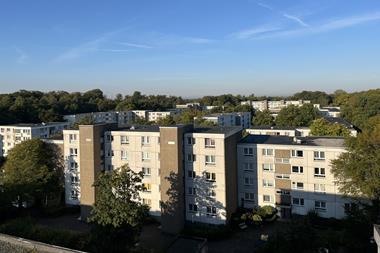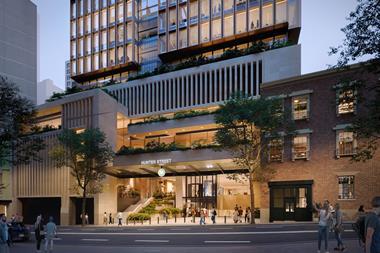An extension of the UK’s office-to-residential permitted development rights (PDR) has been welcomed by the real estate industry.
A three-year window to make office-to-residential conversions was due to expire in May next year.
First introduced in 2013, temporary PDRs enabled offices to be converted to residential use without the need for planning permission.
The activity, popular among developers in London, where there is overwhelming demand for housing, can now continue until May 2019.
Offices can now be converted to light industrial use, in addition to residential.
Melanie Leech, chief executive of the British Property Federation (BPF), welcomed the move.
“We have long championed the extension of office-to-residential PDR, believing the policy to be a useful tool in breathing life back into underused commercial space,” she said.
The policy, Leech said, was “never designed to deliver a huge number of new homes”.
She added: “Any trip through our suburbs soon exposes redundant office space that, with the best will in the world, is never going to be brought back into commercial use, and for such situations this policy is helpful.”
UK-listed company First Property Group has specialised in PDRs. The company has made a £1m (€1.4m) profit using them.
Chief executive Ben Habib said: “The country is facing a housing crisis. It is good for the people in search of homes and good for the economy to convert these hitherto redundant office blocks to residential use.
“No sensible planning policy would favour building homes on green fields over the conversion of these office blocks. The policy is sensible and should be made permanent.”
This year, First Property Group sold the eight properties it converted from office to residential use, generating a 53% return on equity.
First Property’s Fprop PDR fund – backed by a number of investors advised by Towers Watson – was created in October 2013 in response to the UK government’s initial PDR changes.
First Property ended up deploying £30m of capital for the strategy without gearing, returning £16m to investors.
The current exemption of PDR for areas containing strategically important office space remains. Leech said thriving commercial areas such as the City of London “should be protected”.
However, such areas – including the City of London, the London Central Activities Zone and Manchester City Centre – will not be deemed strategically important after 2019.
Anna Cartledge, associate at Shoosmiths, said that, post-2019, central London office locations would no longer be excluded from the PDR automatically, opening up “real opportunities in terms of sites that will attract considerable value for residential use”.
The PDR is going to be expanded to allow office buildings to be demolished and replaced by new-build residential units. The UK government has yet to confirm the limitations attached to this right.
Cartledge said the move could unlock further land for residential use and was consistent with the government’s drive to focus housing provision on previously developed land while protecting the green belt.
The BPF warned, however, that the UK government must “not be too focused on owner occupation”, and that it must encourage development of other tenures if it is to deliver new homes at scale.
In a statement, it added: “It has also outlined how new housing schemes must be accompanied by commercial development, such as shops and leisure facilities, to ensure they are places where people really want to live.”
Leech said the government “must not forget, in its headlong pursuit of creating new homes, that occupation is not the only option.
“The build-to-rent sector has the potential to deliver a huge number of additional homes and to drive up standards in the rental sector, and must not be disregarded in favour of homes for sale – there is room for both,” she said.
UK property advisory firm Daniel Watney recently warned that permanently relaxing PDR for office-to-residential conversions could limit working space.
Charles Mills, partner and head of planning at Daniel Watney, said that while permanently relaxing PDR for office-to-residential conversions would most likely give house building a boost, it was important to protect employment space as well.
“Cities with lots of homes but nowhere to work are just as problematic as ones with lots of offices but nowhere to live,” Mills said.
“There is a danger these latest changes will see yet more disputes between councils and central government at a time when they should be working together to deliver the homes and jobs Britain needs.”
A recently released statement from the British Council of Offices (BCO) said the introduction of PDR had led to some areas of London having to run just to stand still on the provision of new office space.
The research, which looked at the London and Bristol markets, found that PDR has had a substantial impact on the cities’ respective office markets.
BCO’s report estimated that 3,800 and 11,400 homes were created, respectively, in the cities in 2014 as a result of PDR.
Last year, the Commercial Market Survey by the Royal Institute of Chartered Surveyors found that available UK office space was falling at its fastest pace since the late 1990s.
RICS said the rise in transactions of commercial properties being sold with PDR was compounding the lack of availability.
Two-thirds of respondents to the RICS survey suggested that if PDR exemptions were not extended the availability of commercial properties would be impacted further.
In London, 20% of respondents said PDR transactions had led to more than 10% of available commercial properties being earmarked for conversion to residential use.
Simon Rubinsohn, RICS chief economist, said that while PDR was helping in a “small way” to boost much-needed housing supply, the survey suggested that it was also having the unintended consequence of contributing to a shortfall in office space in parts of the UK.
Earlier this year, the UK government said it would also allow casinos to be turned into residential space.












